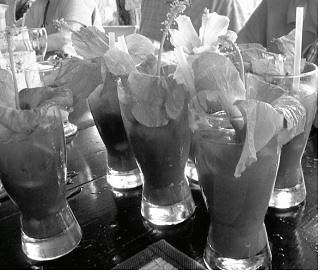GUANACASTE
AND PUNTARENAS
With our luggage back on top of the minibus and covered with a tarpaulin, we headed to Guanacaste Province, named after the national tree of Costa Rica. After driving on an unpaved road for a little over an hour, passing laundry stretched between trees, women under large umbrellas, ranchers on horseback, a toddler waving in his father’s arms, and an occasional truck loaded with sacks, we reached a paved road in the town of Upala. We climbed up a two-lane highway, passing through dense clouds and forest canopy, and crossed the Continental Divide at 495 meters.
The wind picked up as we passed through the Guanacaste volcanic range, and windmills appeared high up in the little town of Bijaghua. Trees blown by the wind all leaned one way. The rain stopped, the sun came out, and the landscape turned to yellow fields under a blue sky with few clouds. Magically, all land became dry on the Pacific side of the Continental Divide. We turned north onto the Pan-American Highway, which connects to California’s Highway One, leading all the way up to Alaska.
After a windy lunch stop at a restaurant called Rincón Corobici, we continued on to Liberia, the provincial capital, for a final break before we drove into the hills near Rincón de la Vieja National Park. It was 80º, a good excuse to indulge in a cone of delicious mango ice cream. This was also a chance to see a supermarket, where the aisles were marked in English. I bought a bottle of Costa Rican vanilla extract, known for its rich flavor, and a bottle of Café Rica, a coffee liqueur similar to Kahlua. I paid in dollars at the day’s exchange rate from colones, which are about 550 to the dollar. A two-ounce bottle of vanilla cost 70¢.
The final stretch of our drive up and down a mountain road and over streams brought us to the Buena Vista Lodge, which lived up to its name as a beautiful spot. As soon as we had settled into our garden villas, we went for a hike through the dry tropical forest. Parrots created the characteristic racket of their mating season; motmots hooted at a distance; purple orchids, the national flower, adorned trees nearby; and enormous strangling ficas stood impressively, choking their host trees with their long branches, whose ends dangled down towards the forest floor.
Returning to a spectacular sunset over the Pacific was our reward for the day. Clouds moving through the setting sun added to the spectacle. Trees became lacy silhouettes against the darkening sky, the stillness broken by an occasional bird flying home.

Ride on the zip-line
The wind roared all night; I fell asleep to the swaying of my curtains as wind pushed through cracks in the window frames. In the morning, which was still windy, we rose early to observe wildlife on an optional forest canopy tour. We hiked to pick up our gear — helmet, harness, and thick gloves. Following a safety talk, we were strapped into harnesses and walked over to a platform at the first of ten trees, to enjoy a ride on a zip-line, consisting of cables stretched between platforms. This was my second such ride, the first having been in the Iguazú rainforest in Argentina. Therefore, I opted for a “taxi ride” with a driver over the thrill of being suspended alone in the air; this allowed me to look around instead of worrying about when to brake. Carlos, my witty young driver, enjoyed entertaining. As we glided between platforms, he sang, performed stunts, made us bounce, and spotted toucans. We returned to the lodge for breakfast.

Thermal pool
A thermal area near the volcano, with pools of hot water and steam vents created by underground streams, was another highlight. Given a choice of transport between horse and tractor, I opted for the latter. The retreat began with ten minutes in a steam room, positioned by a thermal vent in the earth’s crust. Pores opened, I moved to slather mud — too hot to get a handful, but touchable on the surface — onto my body, including my face. Shortly afterwards, I walked, covered with sun-dried mud, into jets of cold water coming at me from opposite directions. Immediately jumping into a pool of hot water at 106º F felt so good that I lingered for a while before moving on to other pools at 75 and 71º. Refreshed and with taut skin, I journeyed back to the lodge.
The best was yet to come — a full body massage by the lodge’s resident masseuse. The woman, who was blind, worked my body on both sides, from my toes to the top of my head. She stopped at my navel, as if listening with her fingers to what was going on under my skin. Disclosing nothing, she continued up my body, including my face and ears. Patting me down with towels to remove the extra oil, she stopped, directed by her inner clock, at the end of precisely one hour. Her parting word was “Bonito,” meaning “All is well.”
On a beautiful still morning in this otherwise windy area, we departed for Puntarenas on the central Pacific coast. As we drove south on the Pan-American Highway, the scenery turned emerald green, roadside stands of watermelon and oval cantaloupes appeared, and traffic picked up. Cars, public buses, trucks, and tractors with logging equipment moved slowly on a road canopied by trees. We stopped for lunch near Monteverde, the country’s cheese center. Given the 95% humidity, my choices were a green salad with palm hearts and coconut ice cream.
After a while we turned onto the coastal road, driving by beaches with black sand and people swimming, fishing, and picnicking under shady trees. Past condominiums, a mango plantation, vendors of sugar cane drinks, and the Latina Fruit Center advertising avocados, cashews, and melons, we arrived at Carara National Park, where we boarded boats for a Jungle Crocodile Safari. The boats cruise the Tarcoles River, which opens into the Pacific Ocean. The river is lined with mangroves, which are havens for birds and crocodiles. The tangled roots of the trees fight tidal erosion, and provide feeding and nesting areas in the underbrush. Big birds roost in the top canopy. Noting the high and low tide marks on the roots, we approached the shore, spotting crocodiles, which are much bigger than caimans. We saw crabs, pelicans, herons, and egrets by the water’s edge and, much to our delight, bright red-and-green macaws in the trees.
Near dusk we reached Monterey del Mar, our hotel, on Esterillos Beach. We immediately rushed to the beach so as not to miss the sunset over the Pacific. We were not disappointed; even the silhouettes of people walking on the beach were a sight to behold. Our meals at this hotel, known for its personalized service, were plated and served, unlike the buffet style of our meals at previous hotels. Fish such as sea bass, mahi-mahi, or tilapia were often on the menu at the places we visited. My room, with its private porch, faced a courtyard with abundant flowers. Missing the ocean view, I made up for it on the hammocks outside.
In the morning a one-hour ride took us to Manuel Antonio National Park. Traveling south on a two-lane highway toward Panama, four hours away, we were on a road lined with African palms and young teak trees. Lean teak trees mature in 15 years when they are cut, as opposed to 30 years for palms; the woods are then replanted. We passed a palm oil factory, went through the town of Parrita, and turned off the road toward the park. Since there is no commercial activity inside the park, the strip we were on was full of signs trying to attract visitors’ attention — signs for hotels, hostels, bed-and-breakfasts, real estate agencies advertising sales and vacancies, restaurants, souvenir shops with jade, and monkey tours.

Capuchin monkey
Downhill past the public beach, we entered Manuel Antonio, a small park that has it all — beach, forest, and wildlife. Changing into bathing suits, we walked down to a white sandy beach. Capuchin monkeys cavorted in trees, families picnicked in the shade, and guides with telescopes led walks on trails, while some of our group enjoyed swimming. After a dip in the warm water, I combed the beach, camera in hand. Children played in pools of water sheltered by boulders, small two-toed gray sloths fed on leaves, raccoons enjoyed picnickers’ leftovers, and an occasional monkey roamed the ground to snatch an unattended water bottle.

Sangria with hibiscus
Following several hours of leisure and relaxation by the beach, we went to a fantastic lunch spot called Ronny’s Place, high on a hill overlooking the ocean. Right away we ordered several pitchers of their famous sangria. The refreshing drink, served in glasses decorated with a red hibiscus flower, included chunks of watermelon, mango, pineapple, and banana. I ordered fish casado, which was mahi-mahi in tomato sauce, black beans, rice, and fried plantains. Vanilla ice cream with chocolate sauce topped the meal. Then we drove through Jaco, a resort town with shops, bars, and a surfers’ beach. Back at the hotel, my day ended with a book on the porch, a lemon daiquiri at the bar, and another gorgeous sunset.
The next morning, the final day of the main trip, we returned to San José in the Central Valley, leaving the humid tropical climate behind. Three stops on the way provided shopping opportunities. Dantica Gallery had high-quality indigenous art and crafts, including masks and embroidered bags, from around Costa Rica. A wood factory offered a quick study of tropical native trees and crafts, such as belts, boxes, and jewelry. Myore’s workshop showed us the high end of Costa Rica’s leather industry. A self-trained designer, Myore carries one-of-a-kind handbags and wallets.
Over a farewell dinner in the evening, we parted company with six group members who were returning home. The other eight went on a post-trip to Tortuguero National Park on the Caribbean coast.
